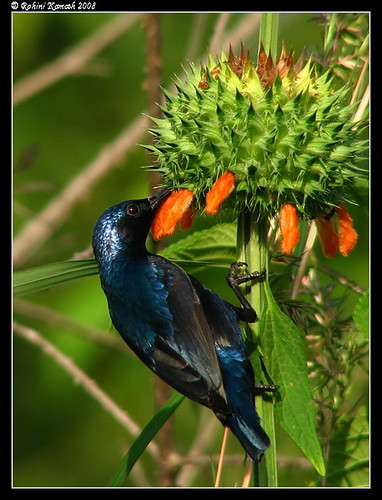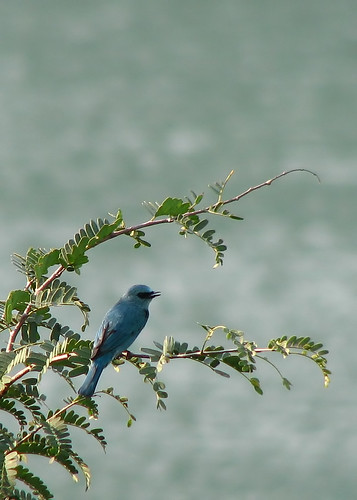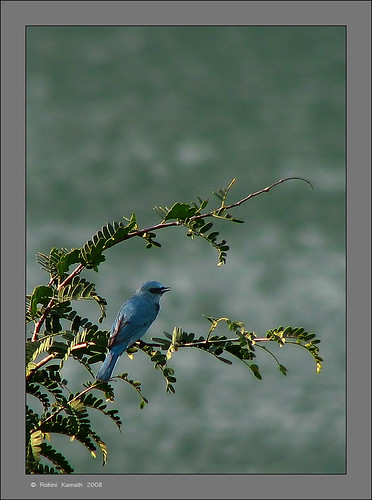
Purple SunBird Male - Manchinbele
I want to take this opportunity to thank my visitors, subscribers, friends and family who have visited this blog and provided kind comments. Thanks guys!!! Criticism and suggestions are welcome, please keep them coming.
I'm not really into Photography for the pictures, I'm really just in it for the birds, the butterflies etc. It is virtually impossible to identify a bird from memory (at least for me). A quick glimpse is not enough to note the details which make all the difference esp. among the smaller feathered wonders.
I took to photography so that I could learn to identify the birds I see. So I don't know a lot about Aperture Priority, Shutter speed etc. I shoot with a non-SLR which makes life simple and keeps the camera light in weight and small in size. I use a Canon Powershot S3 IS. I upgraded around 1.5 yrs ago from my S2.
I did however feel the need to invest in a Tele-converter lens for the S3. A trip to Bandhavgarh and Kanha (my first jungle outing with my Camera) was enough to convince me to upgrade.
One of the laws of birding - the most interesting bird always sits on the tallest possible tree, usually against the sun and with its back turned to you.
So 12x zoom just wasn't enough reach. I use TC-DC58B by Canon. My teleconverter adapter is from Lensmate. Canon makes plastic adapters and I wanted a metal one, since the adpater is grooved and the plastic adapter grooves can get warped if wrongly screwed in.
Later trips to Ranthambore and Bharatpur have convinced me that the reach I get with this combination is sufficient to keep me satisfied for sometime at least. A prosumer camera can never beat a SLR, but it can make your travel lighter and make sure you don't develop biceps. I would need a caddy. ( Keshav, pls note ;) )
Lessons I learnt with the TC
Initially there was great disappointment in store for me with the TC. The pictures were soft when hand held, the shake was amplified (I don't have steady hands) and the clarity just wasn't there.
To beat this problem, I used a tripod with considerable success. Tripod is as tall as self so I don't have to stoop ( like Keshav does ). First field trial was in Katpady Village in our backyard. Since the area to be covered was limited (1 acre), I simply set it up each morning and waited for hours. This strategy produced some amazingly clear pictures for the first time with the TC. The tripod eliminated shake, so I was able to get my first clear photo of a fidgety purple rumped sun bird as it sat on a flower larger than itself.
Let there be light!
On a trip to Madivala lake, on an overcast day, the tripod+camera+TC combo flopped, the photos were ok but soft. I have discovered that for optimum clarity one needs full sunlight. This is clearly not good for ones complexion, but its sadly the only way I have for now.
Tripods are a problem to carry around (for me), setting them up takes time and it means no flexibility in movement. As I got more familiar with the camera I found that I could do without the tripod. Sure, the photos wont be as great, but at least I'll get more photos (since I'm in it for the birds and not great photos)
Using the Car
On recent trips, we have been birding from the Car. This gives great camouflage and its great to use the door to steady the hand. The purple sunbird photo at the top of this post was taken handheld from around 5 feet from the bird; from the car.
I have also found that I can climb out and sit on the door (with my feet inside, on the seat) and rest my elbows on the roof of the car to get a better picture. The following photo was taken this way, since the bird was on the driver side and on a electric wire, it was very awkward to shoot.

Red Rumped Swallow - Manchinbele
The holy trinity - The Camera, the lens and the photoeditor
I first used Picassa to process the photos - I would usually just crop and straighten the horizon (I can never get the horizon straight) and add a border.
Keshav introduced me to ACDSee PhotoEditor I use ver 3.1. and members of INW introduced me to Neat Image ( to filter out noise ).
I tried Gimp, but the complexity put me off since the time taken to master it was too great. Photoshop was complex too, with the manual being bigger than the executable. Recently though after closely watching Keshav use Photoshop (marriage has its uses) I find its not that hard.
 Cropped,Unprocessed |  Filtered and sharpened With Neat Image |
 Processed by me using ACDSee Processed by me using ACDSee |  Processed by Keshav-Photoshop Processed by Keshav-Photoshop |
How one processes the photo is a matter of taste, the possibilities are endless.
Pls Note: For those who wanted to know, the Barbet photo was not processed to eliminate branches/twigs/leaves. But I did have to remove a distracting seed pod in the Oriole Photo. I was in a hurry, so the job is not as neat as usual. :)
For those interested, we visited Bannerghatta Butterfly park last week on an impromptu visit, a post and few photos will follow soon.






9 comments:
Hi,
As usual, in detail and depth information, got a few things and good to know ur improvisation with the camera and photoshop.
Keep Birding!
Keep Posting!
Keep Rocking!
regards,
santosh.
I liked the first photo.
Since you are speaking about post processing, a few thoughts of mine too: I believe that post processing should make the photo taken as close to the view which you had seen while taking the photo, anything more would make it artificial. 50% of the photo is completed the moment you imagine what to take and more than 90% is done once u press the shutter button - that leaves only about 10% to play around with :)
@Santosh:
Thanks for visiting! It is very encouraging to get comments and suggestions :)
@anoop:
I like the first photo too. The swallow is a record shot, my first image of it sitting still in light. Usually they are fidgety birds.
I find though that I can never take photos that are as amazing as the real thing - when considering landscapes.
But when it comes to birds, the snaps are helpful, a way to freeze time and see the bird properly, with all details and having no fear that it will fly away :)
Rohini Enjoyed going thro' the post.You have made it sound so simple-gives me some hope!
Ranjini Aunty
Informative post. I almost have given up even trying to photograph except for the times when the bird is really close and it feels criminal to not click :)
@Ranjini Aunty:
Thanks for your continued encouragement and readership!
@Neelu:
Thanks for the comments. I have seen your recent Kestrel snaps of Hesarghatta. We had such poor luck there, Im almost afraid to re-visit.
hi rohini,
today i accidentally found your blog and i liked it very much. :)
Post a Comment
Please do not post ADs here, they will not be published. All comments are moderated.